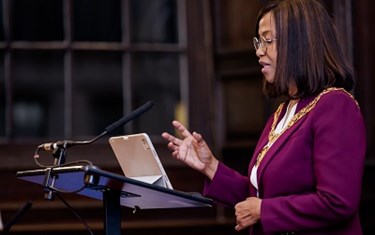In the second of our series of blogs to celebrate Women's History Month, Dr Roisin Willmott OBE FRTPI, Director of Wales and Northern Ireland and Planning Aid England, writes about her heroine Betty Campbell MBE.
 It’s a great privilege for me to share with you one of my heroines and an early influencer in my planning career - Betty Campbell MBE. Who is Betty Campbell, I hear you ask? Rachel Elizabeth Johnson was born in the Cardiff Docks area, popularly known as Tiger Bay, to a Jamaican father and Welsh Barbadian mother, into a working class family. She overcame racism and hostility and eventually became Wales’ first black headteacher. In the BBC’s Hidden heroines, they describe her as a champion of multiculturalism. She was an impassioned champion of her community and became councillor for Butetown in 1999 to 2004.
It’s a great privilege for me to share with you one of my heroines and an early influencer in my planning career - Betty Campbell MBE. Who is Betty Campbell, I hear you ask? Rachel Elizabeth Johnson was born in the Cardiff Docks area, popularly known as Tiger Bay, to a Jamaican father and Welsh Barbadian mother, into a working class family. She overcame racism and hostility and eventually became Wales’ first black headteacher. In the BBC’s Hidden heroines, they describe her as a champion of multiculturalism. She was an impassioned champion of her community and became councillor for Butetown in 1999 to 2004.
Betty sat on the UK government’s race relations advisory board and introduced Black History Month to the school curriculum, so a fitting subject for this blog marking Women’s History Month.
In the early days of my career working at the Vale of Glamorgan Borough Council (pre the 1996 local government reorganisation), I attended a Conference in Cardiff on the proposed Cardiff Bay Barrage and Cardiff Bay redevelopment – “Europe’s largest waterfront redevelopment”, as it was posted at the time. It was a controversial scheme, impounding Cardiff Bay and the loss of the “unsightly” mud flats (and bird feeding grounds) to make way for gleaming new development and housing. All of this taking place the other side of the tracks from Butetown, a part of Cardiff with high deprivation and a multicultural community. There were no plans to invest in this area as part of the proposals; there was clear delineation between the two areas.
I have attended many many conferences over the years and I don’t recall many of those who have asked questions, except for one individual at this Conference; the memory of them challenging the panel, chaired by John Humphrys, still sits with me.
I was new to the professional world but this petite, yet formidable individual impressed me. Betty Campbell stood up and pushed the panel for answers about the community she so proudly lived in and worked in as the local primary school head. She was articulate, challenging, passionate and yet caring. The room, of mainly suited men, took note.
She brought to the fore the human scale impact of the proposals. This is what has stayed with me to this day.
Despite this, the Act of Parliament and the proposals went ahead, with their back turned on Butetown. Although there has been more recent activity to provide better integration and improvements.
Back in the early 1990s, if we are honest, there was limited engagement or involvement. Yes, there was consultation, as required by law, but limited genuine community engagement. This has changed in Wales with the Well-being of Future Generations Act’s five ways of working which requires involvement.
Betty Campbell demonstrated to me the need for true community engagement; not because communities are making noise or a nuisance of themselves, but because they can have genuine need which needs to be considered, and they can make valuable contributions. Although this engagement has arguably become more challenging with the growth of social media and the difficulties this presents in breaking though the noise made by a minority, to focus on the genuine issues.
Betty Campbell remained committed to the heritage of Butetown and the importance of its multiculturalism throughout her life: “In our own unique way we were establishing an area where religion, colour didn’t matter – we all respected each other as people.”
In 2021, just a short walk from the RTPI Office in Cardiff in the new Central Square area, a statue of Betty Campbell was unveiled. It is believed to be the first statue of a named, non-fictional woman in an outdoor public space in Wales.
The four-metre high statue is itself a remarkable piece of placemaking. It was designed and created by Eve Shepherd, following a public vote from a shortlist of five historical Welsh women. Mrs Campbell's head and shoulders form a canopy, beneath which are ten young children. The Sculptor explains that she was inspired by the concept of mother trees within woodlands; "Using that analogy I thought that was like Betty - she reminds me of a mother tree to her community. She protected her community, her children, her school. She was so strongly connected, so respected and she educated and she gave parts of herself for the good of the community."
The statue includes children, books and a quote from Betty Campbell in English and Welsh: "We were a good example to the rest of the world, how you can live together regardless of where you come from or the colour of your skin." The children's feet are embedded into a section of a map of Tiger Bay so that the children, Betty and anyone sitting on the statue are 'growing' out of it. The statue also includes seats with the intention that others can come and sit under the canopy.
The statue holds as a reminder to me of the importance and value of involvement and listening to the voices in our communities.


